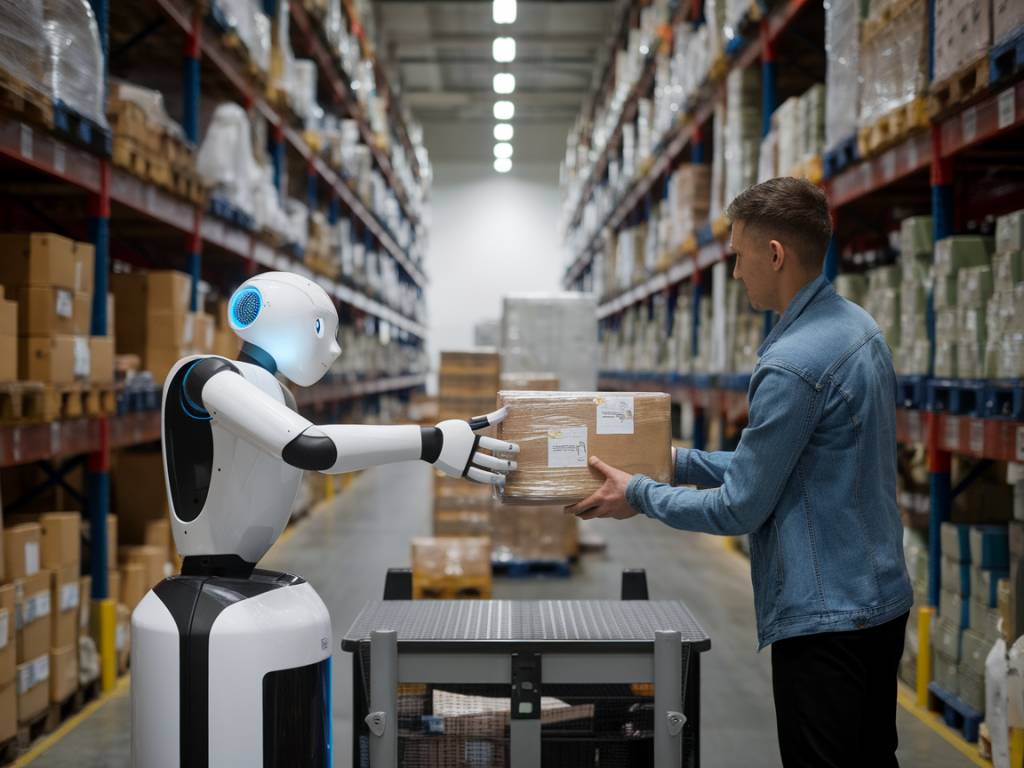In today’s fast-paced and increasingly automated world, the logistics industry continuously seeks innovative solutions to enhance efficiency and productivity. One of the most transformative changes in recent years is the introduction of collaborative robots, often known as cobots. These advanced machines work alongside humans, significantly enhancing human capabilities and optimizing operations. This blog post delves into how collaborative robots are revolutionizing the logistics sector and why their adoption is a growing trend.
Understanding Collaborative Robots (Cobots)
Collaborative robots or cobots are designed to work with human operators in a shared workspace. Unlike traditional industrial robots, which often require isolation for safety reasons, cobots are equipped with advanced sensors and programming to ensure they operate safely alongside humans. Their primary role is to assist with repetitive, physically demanding, or dangerous tasks, thereby augmenting human labor instead of replacing it.
The Rise of Cobots in Logistics
The logistics industry, encompassing activities like warehousing, distribution, and transportation, is perfectly poised to benefit from the integration of cobots. Several factors contribute to the increasing use of cobots in this sector, including:
With these driving forces in play, cobots are emerging as essential tools for logistics operations.
Applications of Cobots in Logistics
Cobots are versatile and can be employed in various logistics tasks. Below are some key applications:
Warehouse Automation
One of the most significant applications of cobots in logistics is warehouse automation. Cobots can handle tasks such as:
These applications not only increase efficiency but also reduce errors and improve safety in the workplace.
Material Handling
Cobots excel in material handling, including loading and unloading goods from trucks or containers. By integrating sensors and cameras, they can navigate complex environments, ensuring the timely and safe movement of goods.
Inventory Management
With RFID and barcode scanning capabilities, cobots can perform real-time inventory audits and updates. This ensures accurate inventory levels, reduces the chances of stockouts, and optimizes stock management.
Advantages of Using Cobots in Logistics
The rising popularity of cobots in logistics stems from a range of benefits. Here are some of the key advantages:
Improved Efficiency
Cobots can work continuously without breaks, leading to higher throughput rates. They also bring consistency to repetitive tasks, reducing errors and enhancing overall efficiency.
Cost-Effectiveness
While the initial investment in cobots can be substantial, the long-term cost savings are significant. Reduced labor costs, lower error rates, and improved efficiency contribute to a favorable return on investment.
Enhanced Safety
Collaborative robots are designed with safety in mind. They have built-in sensors that can detect human presence and immediately stop operations to prevent accidents. This ensures a safer working environment for human operators.
Scalability
Cobots offer scalability for logistics operations. You can easily add more cobots as your business grows, making it a flexible solution to meet increasing demands.
Challenges and Considerations
While the benefits of cobots are compelling, their adoption does come with challenges. Logistics companies must address several factors to maximize the efficacy of cobots:
Initial Investment
The upfront cost of purchasing and integrating cobots can be significant. Companies need to weigh these costs against the long-term benefits to determine feasibility.
Training and Adaptation
Human operators need training to work effectively alongside cobots. This involves learning new skills and adapting to a more automated workspace. Adequate support and training programs are essential for smooth integration.
Technical Issues
Like any technological tool, cobots can face technical issues. Regular maintenance and updates are necessary to ensure optimal performance and prevent downtime.
Data Security
With increased automation comes the need for robust data security measures. Companies must ensure that their cobots are secure against cyber threats to protect sensitive information.
Future Trends in Cobots for Logistics
The future of cobots in logistics looks promising as technology continues to evolve. Here are some trends to watch:
AI and Machine Learning
Advancements in AI and machine learning will make cobots even more efficient and capable. They will be able to learn from their experiences and improve their performance over time.
Integration with IoT
The integration of cobots with the Internet of Things (IoT) will enable smarter, connected logistics ecosystems. Cobots will communicate with other devices, creating a seamless and highly efficient operation.
Customization
Future cobots will offer greater customization options, allowing businesses to tailor them to specific needs and workflows. This will enhance their versatility and applicability across different logistics tasks.
Collaboration with Humans
As cobots become more advanced, the human-cobot collaboration will become more sophisticated. Cobots will take on more complex tasks, freeing up human workers to focus on higher-level decision-making and problem-solving.
In conclusion, collaborative robots are set to play a crucial role in the future of logistics. By enhancing human capabilities and optimizing operations, cobots offer a compelling solution to the industry’s most pressing challenges. As technology continues to advance, the potential for cobots in logistics is bound to expand, promising a more efficient and productive future.

